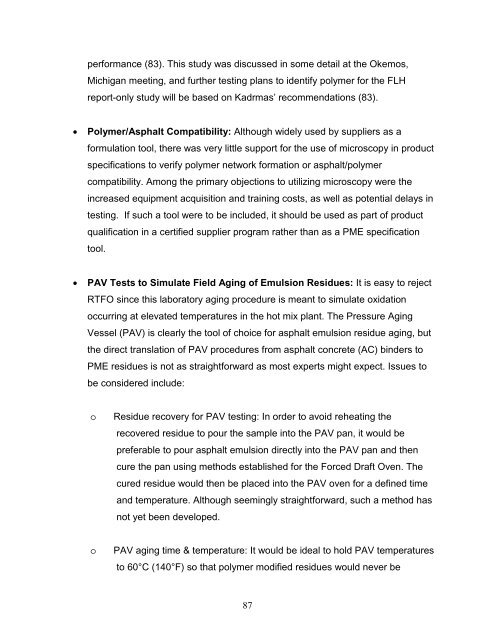Using Polymer Modified Asphalt Emulsions in Surface Treatments A ...
Using Polymer Modified Asphalt Emulsions in Surface Treatments A ...
Using Polymer Modified Asphalt Emulsions in Surface Treatments A ...
You also want an ePaper? Increase the reach of your titles
YUMPU automatically turns print PDFs into web optimized ePapers that Google loves.
performance (83). This study was discussed <strong>in</strong> some detail at the Okemos,<br />
Michigan meet<strong>in</strong>g, and further test<strong>in</strong>g plans to identify polymer for the FLH<br />
report-only study will be based on Kadrmas’ recommendations (83).<br />
• <strong>Polymer</strong>/<strong>Asphalt</strong> Compatibility: Although widely used by suppliers as a<br />
formulation tool, there was very little support for the use of microscopy <strong>in</strong> product<br />
specifications to verify polymer network formation or asphalt/polymer<br />
compatibility. Among the primary objections to utiliz<strong>in</strong>g microscopy were the<br />
<strong>in</strong>creased equipment acquisition and tra<strong>in</strong><strong>in</strong>g costs, as well as potential delays <strong>in</strong><br />
test<strong>in</strong>g. If such a tool were to be <strong>in</strong>cluded, it should be used as part of product<br />
qualification <strong>in</strong> a certified supplier program rather than as a PME specification<br />
tool.<br />
• PAV Tests to Simulate Field Ag<strong>in</strong>g of Emulsion Residues: It is easy to reject<br />
RTFO s<strong>in</strong>ce this laboratory ag<strong>in</strong>g procedure is meant to simulate oxidation<br />
occurr<strong>in</strong>g at elevated temperatures <strong>in</strong> the hot mix plant. The Pressure Ag<strong>in</strong>g<br />
Vessel (PAV) is clearly the tool of choice for asphalt emulsion residue ag<strong>in</strong>g, but<br />
the direct translation of PAV procedures from asphalt concrete (AC) b<strong>in</strong>ders to<br />
PME residues is not as straightforward as most experts might expect. Issues to<br />
be considered <strong>in</strong>clude:<br />
o<br />
Residue recovery for PAV test<strong>in</strong>g: In order to avoid reheat<strong>in</strong>g the<br />
recovered residue to pour the sample <strong>in</strong>to the PAV pan, it would be<br />
preferable to pour asphalt emulsion directly <strong>in</strong>to the PAV pan and then<br />
cure the pan us<strong>in</strong>g methods established for the Forced Draft Oven. The<br />
cured residue would then be placed <strong>in</strong>to the PAV oven for a def<strong>in</strong>ed time<br />
and temperature. Although seem<strong>in</strong>gly straightforward, such a method has<br />
not yet been developed.<br />
o<br />
PAV ag<strong>in</strong>g time & temperature: It would be ideal to hold PAV temperatures<br />
to 60°C (140°F) so that polymer modified residues would never be<br />
87
















